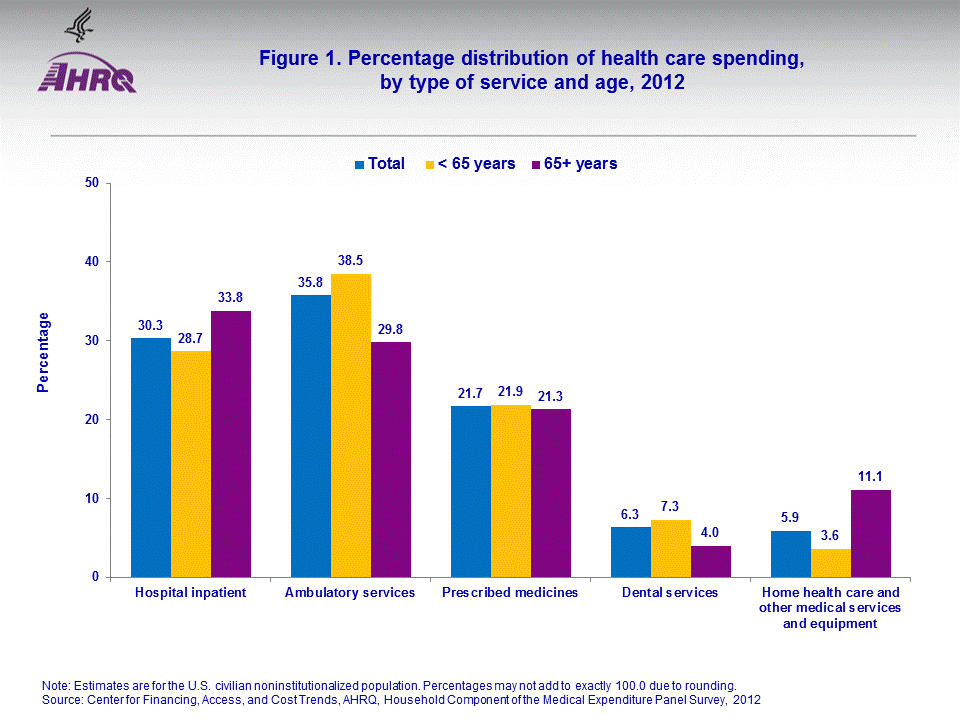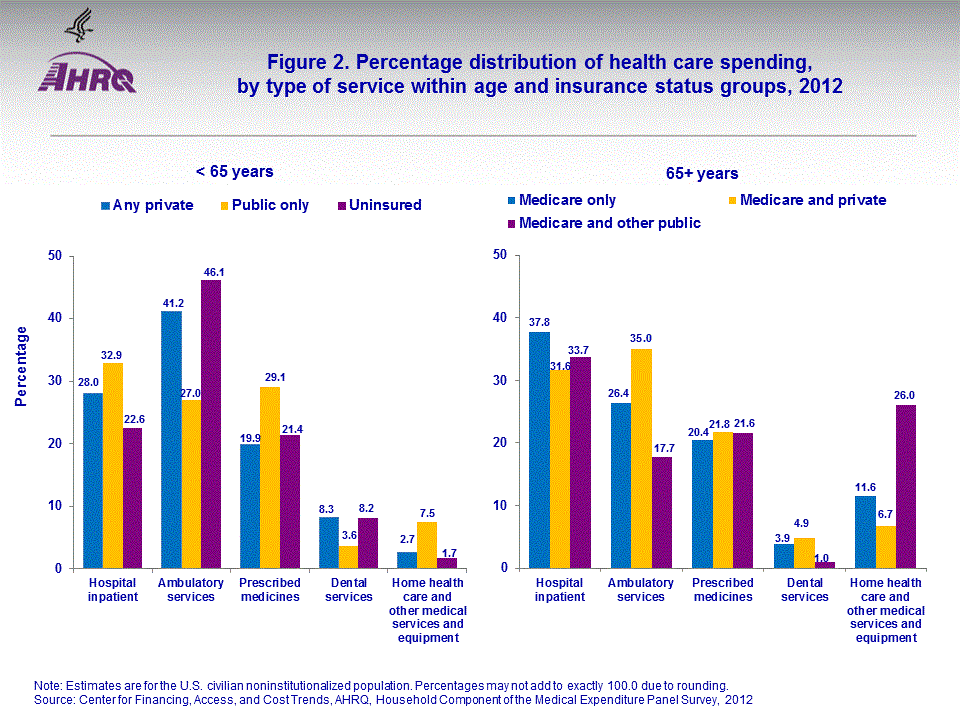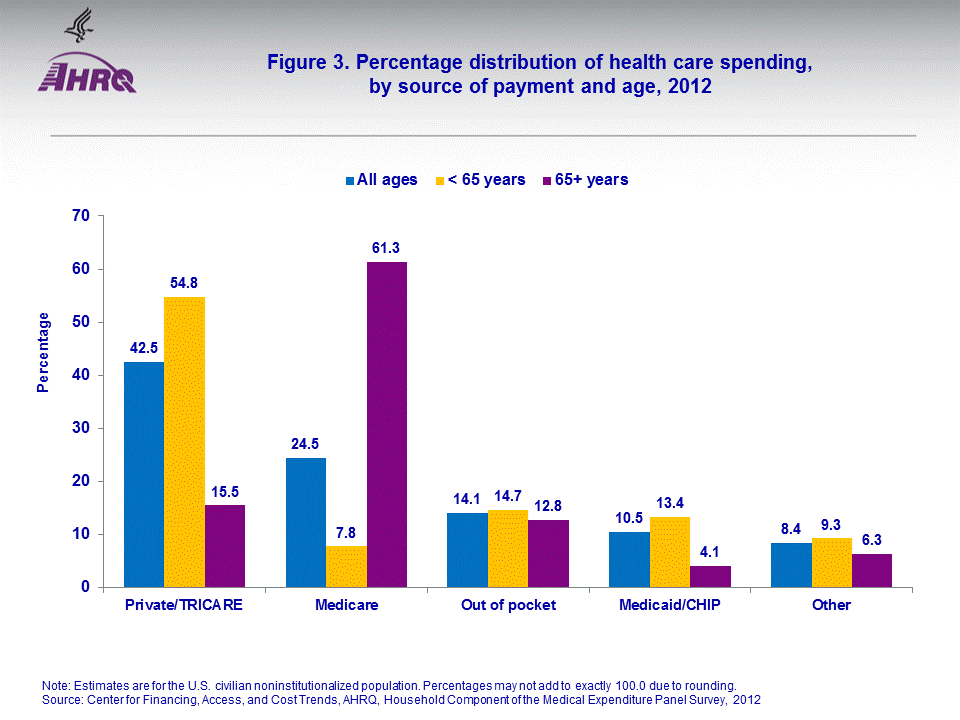
|
|
Font Size:
|
||||
|
|
|
|
||||
STATISTICAL BRIEF #456:
National Health Care Expenses in the U.S. Civilian Noninstitutionalized Population, Distributions by Type of Service and Source of Payment, 2012
Highlights
- Hospital inpatient expenses accounted for approximately one-third of total health care expenses for the U.S. civilian noninstitutionalized population, while prescribed medicines accounted for approximately one-fifth of total expenses.
- Among persons under age 65, the uninsured and those with any private insurance had a larger proportion of their health care spending for ambulatory services (office-based visits, hospital outpatient care, and emergency room care) compared to those with public insurance only.
- Among the elderly, those with Medicare and private insurance had a larger proportion of their health care spending for ambulatory services than those with Medicare only or Medicare and other public insurance.
- Private insurance paid for 42.5 percent of total expenses, Medicare paid 24.5 percent, individuals and family members paid 14.1 percent out of pocket, Medicaid/CHIP paid 10.5 percent, and other sources paid 8.4 percent.
- The proportion of total expenses paid out of pocket was lower for elderly persons than persons under age 65.
Introduction
This Statistical Brief presents estimates of distributions of health care spending by type of service and distributions by payment sources within age and insurance groups for the U.S. civilian noninstitutionalized population in 2012.Health care expenses, as reported in this Brief, represent payments to hospitals, physicians, and other health care providers based on health care use information collected in the Medical Expenditure Panel Survey (MEPS) Household Component and payment data collected in both the MEPS Household and Medical Provider Components. Expense estimates include amounts paid by individuals, private insurance, Medicare, Medicaid, and the Children's Health Insurance Program (CHIP), and other payment sources. All differences between estimates discussed in the text are statistically significant at the 0.05 level.
Findings
In 2012, there was an estimated total of $1.351 trillion paid for health care received by the U.S. civilian noninstitutionalized population distributed among various health care use service categories including hospital inpatient and outpatient care, emergency room services, office-based medical provider services, dental services, home health care, prescription medicines, and other medical services and equipment. Hospital inpatient expenses for both facility and separately billed physician services accounted for 30.3 percent of total expenses for the total population. Hospital inpatient expenses comprised a higher percentage for the elderly (33.8 percent) when compared to the under age 65 population (28.7 percent) (figure 1). While 35.8 percent of total expenses was attributable to ambulatory care provided in office-based settings, hospital outpatient departments, and emergency rooms, the elderly had a lower proportion of total expenses for ambulatory care (29.8 percent) than the under age 65 population (38.5 percent). Expenses for prescribed medicines comprised about one-fifth of expenses for the total population (21.7 percent), the elderly (21.3 percent), and persons under age 65 (21.9 percent). Dental services expenses accounted for 6.3 percent of overall expenses, but this proportion was somewhat lower for persons age 65 and older than persons under age 65 (4.0 versus 7.3 percent). Expenses for home health services and other medical services and equipment was 5.9 percent for the total population, but for the elderly this proportion was about three times that for persons under age 65 (11.1 percent versus 3.6 percent).Among persons under age 65, those with public insurance only had higher percentages of health care spending for prescribed medicines (29.1 percent) and home health and other medical services and equipment (7.5 percent) when compared to those with any private insurance (19.9 percent and 2.7 percent) and the uninsured (21.4 percent and 1.7 percent) (figure 2). Persons under age 65 with only public insurance also had a higher percentage of health care spending for hospital inpatient services when compared to those that were uninsured (32.9 percent versus 22.6 percent). Moreover, for persons under age 65, those with public insurance only had a lower percentage of health care spending on ambulatory services and dental services (27.0 percent and 3.6 percent) when compared to those with any private insurance (41.2 percent and 8.3 percent) and the uninsured (46.1 percent and 8.2 percent). In addition, persons under age 65 with any private insurance had a lower percentage of spending on home health and other medical services and equipment (2.7 percent) when compared with those that were uninsured (1.7 percent).
Health care expenses are paid largely by third-party payers (e.g., private and public sources of payment) (figure 3). In 2012, private insurance paid 42.5 percent of total expenses, Medicare paid 24.5 percent, individuals and family members paid 14.1 percent out of pocket, Medicaid/CHIP paid 10.5 percent, and other sources paid 8.4 percent (figure 3). Private insurance paid over half (54.8 percent) of expenses for persons under age 65 versus only 15.5 percent for the elderly. Conversely, Medicare paid nearly two-thirds of expenses (61.3 percent) for persons age 65 and older and only 7.8 percent for those under age 65. Moreover, Medicaid/CHIP paid for 13.4 percent of expenses for persons under age 65 compared to a smaller percentage for persons age 65 and older, 4.1 percent. Individuals and family members of the under 65 population paid a higher percentage of total expenses out of pocket (14.7 percent) than the age 65 and older population (12.8 percent).
Data Source
The estimates in this Statistical Brief are based upon data from the MEPS HC-155: 2012 Full Year Consolidated Data File.Definitions
ExpendituresExpenditures include total direct payments from all sources to hospitals, physicians, home health providers (agency and paid independent providers), dental providers, other types of health care providers (e.g., physical therapists, chiropractors, optometrists, etc.), and pharmacies for services reported by respondents in the MEPS-HC. Expenditures for hospital-based services include those for both facility and separately billed physician services.
Sources of payment
- Out of pocket: This category includes expenses paid by the user or other family member.
- Private insurance: This category includes payments made by insurance plans covering hospital and medical care (excluding payments from Medicare, Medicaid, and other public sources). Payments from Medigap plans or TRICARE (Armed Forces-related coverage) are included.
- Medicare: Medicare is a federally financed health insurance plan for persons age 65 and older, persons receiving Social Security disability payments, and persons with end-stage renal disease. Medicare Part A, which provides hospital insurance, is automatically given to those who are eligible for Social Security. Medicare Part B provides supplementary medical insurance that pays for medical expenses and can be purchased for a monthly premium. Medicare Part D provides optional coverage for prescribed medicines.
- Medicaid/CHIP: Medicaid and CHIP are means-tested government programs jointly financed by federal and state funds that provide health care to those who are eligible. Medicaid is designed to provide health coverage to families and individuals who are unable to afford necessary medical care, while CHIP provides coverage to additional low income children not eligible for Medicaid. Eligibility criteria for both programs vary significantly by state.
- Other sources: This category includes payments from the Department of Veterans Affairs (except TRICARE); other federal sources (Indian Health Service, military treatment facilities, and other care provided by the Federal government); various state and local sources (community and neighborhood clinics, state and local health departments, and state programs other than Medicaid/CHIP); Workers' Compensation; various unclassified sources (e.g., automobile, homeowner's, or other liability insurance, and other miscellaneous or unknown sources); Medicaid/CHIP payments reported for persons who were not reported as enrolled in the Medicaid or CHIP programs at any time during the year; and private insurance payments reported for persons without any reported private health insurance coverage during the year.
Individuals under age 65 were classified in the following three insurance categories, based on household responses to health insurance status questions:
- Any private health insurance: Individuals who, at any time during the year, had insurance that provides coverage for hospital and physician care (other than Medicare, Medicaid/CHIP, or other public hospital/physician coverage) were classified as having private insurance. Coverage by TRICARE (Armed Forces-related coverage) was also included as private health insurance. Insurance that provides coverage for a single service only, such as dental or vision coverage, was not included.
- Public coverage only: Individuals were considered to have public coverage only if they met both of the following criteria: 1) They were not covered by private insurance at any time during the year; and 2) They were covered by any of the following public programs at any point during the year: Medicare, Medicaid/CHIP, or other public hospital/physician coverage.
- Uninsured: The uninsured were defined as people not covered by private hospital/physician insurance, Medicare, TRICARE, Medicaid/CHIP, or other public hospital/physician programs at any time during the entire year or period of eligibility for the survey.
- Medicare and private insurance: This category includes persons classified as Medicare beneficiaries and covered by Medicare and a supplementary private policy.
- Medicare and other public insurance: This category includes persons classified as Medicare beneficiaries who met both of the following criteria: 1) They were not covered by private insurance at any point during the year; and 2) They were covered by one of the following public programs at any point during the year: Medicaid, other public hospital/physician coverage.
- Medicare only: This category includes persons classified as Medicare beneficiaries but not classified as Medicare and private insurance or as Medicare and other public insurance. This group includes persons who were enrolled in Medicare Advantage (Part C) and persons who had traditional Medicare fee-for-service coverage only.
About MEPS-HC
MEPS-HC is a nationally representative longitudinal survey that collects detailed information on health care utilization and expenditures, health insurance, and health status, as well as a wide variety of social, demographic, and economic characteristics for the U.S. civilian noninstitutionalized population. It is cosponsored by the Agency for Healthcare Research and Quality (AHRQ) and the National Center for Health Statistics.MEPS expenditure data are derived from both the Medical Provider Component (MPC) and Household Component (HC). MPC data are generally used for hospital-based events (e.g., inpatient stays, emergency room visits, and outpatient department visits), prescribed medicine purchases, and home health agency care. Office based physician care estimates use a mix of HC and MPC data, while estimates for non-physician office visits, dental and vision services, other medical equipment and services, and independent provider home health care services are based on HC-provided data. Details on the estimation process can be found in Machlin, S. R. and Dougherty, D.D. Overview of Methodology for Imputing Missing Expenditure Data in the Medical Expenditure Panel Survey. Methodology Report No. 19. March 2007. Agency for Healthcare Research and Quality, Rockville, MD. http://www.meps.ahrq.gov/mepsweb/data_files/publications/mr19/mr19.shtml
For more information about MEPS, call the MEPS information coordinator at AHRQ (301-427-1406) or visit the MEPS Web site at http://www.meps.ahrq.gov/.
References
Cohen, J. Design and Methods of the Medical Expenditure Panel Survey Household Component. MEPS Methodology Report No. 1. AHCPR Pub. No. 97-0026. Rockville, MD: Agency for Health Care Policy and Research, 1997. http://www.meps.ahrq.gov/mepsweb/data_files/publications/mr1/mr1.shtmlCohen, S. Sample Design of the 1996 Medical Expenditure Panel Survey Household Component. MEPS Methodology Report No. 2. AHCPR Pub. No. 97-0027. Rockville, MD: Agency for Health Care Policy and Research, 1997. http://www.meps.ahrq.gov/mepsweb/data_files/publications/mr2/mr2.shtml
Cohen, S. Design Strategies and Innovations in the Medical Expenditure Panel Survey. Medical Care, July 2003: 41(7) Supplement: III-5–III-12.
Ezzati-Rice, T.M., Rohde, F., Greenblatt, J. Sample Design of the Medical Expenditure Panel Survey Household Component, 1998–2007. Methodology Report No. 22. March 2008. Agency for Healthcare Research and Quality, Rockville, MD. http://www.meps.ahrq.gov/mepsweb/data_files/publications/mr22/mr22.shtml
Sing, M., Banthin, J., Selden, T., et al.: Reconciling Medical Expenditure Estimates from the MEPS and NHEA, 2002. Health Care Financing Review 28(1):25–40, Fall 2006. https://www.cms.gov/HealthCareFinancingReview/downloads/06Fallpg25.pdf
Suggested Citation
Stagnitti, M.N. and Carper, K. National Health Care Expenses in the U.S. Civilian Noninstitutionalized Population, Distributions by Type of Service and Source of Payment, 2012.Statistical Brief #456. November 2014. Agency for Healthcare Research and Quality, Rockville, MD. http://www.meps.ahrq.gov/mepsweb/data_files/publications/st456/stat456.shtmlAHRQ welcomes questions and comments from readers of this publication who are interested in obtaining more information about access, cost, use, financing, and quality of health care in the United States. We also invite you to tell us how you are using this Statistical Brief and other MEPS data and tools and to share suggestions on how MEPS products might be enhanced to further meet your needs. Please email us at MEPSProjectDirector@ahrq.hhs.gov or send a letter to the address below:
Steven B. Cohen, PhD, Director
Center for Financing, Access, and Cost Trends
Agency for Healthcare Research and Quality
540 Gaither Road
Rockville, MD 20850
 |
|||||||||||||||||||||||||||||||||||||||||||||||||
|
|||||||||||||||||||||||||||||||||||||||||||||||||
|
|
|||||||||||||||||||||||||||||||||||||||||||||||||
 |
|||||||||||||||||||||||||||||||||||||||||||||||||
|
|||||||||||||||||||||||||||||||||||||||||||||||||
|
|
|||||||||||||||||||||||||||||||||||||||||||||||||
 |
|||||||||||||||||||||||||||||||||||||||||||||||||
|
|||||||||||||||||||||||||||||||||||||||||||||||||
|
|
|||||||||||||||||||||||||||||||||||||||||||||||||


